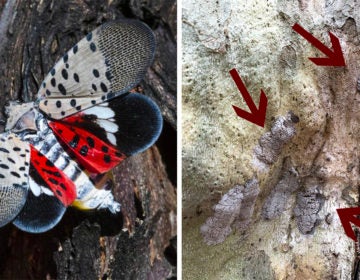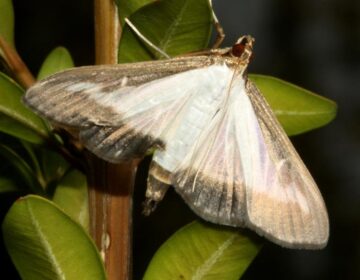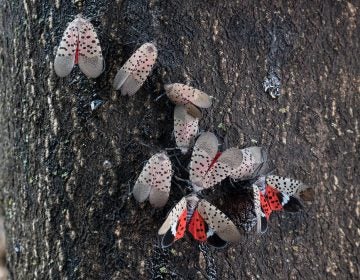Summer is at its peak. So is the spotted lanternfly
Following the lanternfly’s arrival to New Jersey, the state’s Department of Agriculture issued a quarantine zone that encompassed eight N.J. counties.
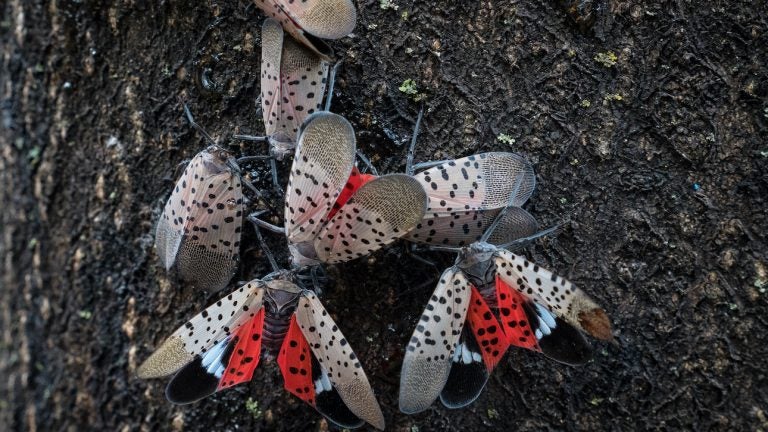
The spotted lanternfly is a destructive insect that feeds on a wide range of fruit, ornamental, and hardwood trees, including grapes, apples, walnut, and oak. (Lance Cheung/USDA)
This story originally appeared on NJ Spotlight.
One of New Jersey’s newest invasive species, the spotted lanternfly, fully matures in July, when its wings become splashed with a bright, black-specked crimson.
Their striking color and 1-inch size make spotted lanternflies easy to recognize, but so does their behavior — look closely at any one of some 70 plant species across the state, and you just might find a mob of the pests, busy draining tree trunks, stems and leaves of the sap these plants need to survive.
A native of China, India and Vietnam, the lanternfly was first observed in the United States in 2014, in Berks County, Pennsylvania. According to Cornell University, the “planthopper” species arrived in the U.S. as egg masses attached to a shipment of stone. By 2018, the insect had made its way to New Jersey, where it quickly spread throughout much of the state.
Only Cape May and Ocean counties have been spared — for now.
“There have been reports in those counties,” said Anne L. Nielsen, director of the Rutgers graduate program in entomology. “But it is not known if they were hitchhiking bugs or a breeding population.”
The New York State Integrated Pest Management Program has mapped the lanternfly’s spread, and, as of July 26, the pest has expanded into Maine, Massachusetts, Connecticut, New York, Ohio, Indiana, West Virginia, Virginia, Maryland, Delaware, and North Carolina. The USDA also notes recent sightings in Rhode Island and Oregon.
Sucks sap, excretes honeydew
The lanternfly’s preferred host is the deciduous Tree-of-heaven, itself an invasive species native to China that was brought to North America centuries ago. The New Jersey Department of Agriculture recommends clearing property of the tree to reduce the risk of lanternfly infestation. But the insect has quickly adapted to living off other woody plants native to North America. Apple, peach, walnut, maple, tulip poplar, black cherry, hops, and especially wild and commercially grown grapes, are now also targets of the bug.
When it feeds, the lanternfly uses its piercing mouthparts to suck sap from plants. That reduces the plants’ available energy, potentially weakening them and making them susceptible to diseases and even death. The bug’s intensive feeding behavior causes it to excrete large amounts of honeydew, a sugary substance that stimulates the growth of a black mold on plants that, while not harmful to humans, can attract other insects like wasps, hornets and ants. A large, sustained infestation may also cause wounds to develop on tree trunks and branches.
“This intense feeding just saps the energy from plants, and that makes it tough for some of them to thrive,” said Amy Korman, an entomologist and Penn State Extension Horticulture educator.
Following the pest’s initial arrival in Pennsylvania, grape growers there reported “direct vine losses due to reduction in cold hardiness and plant health” after experiencing lanternfly infestations, according to Rutgers’ New Jersey Agricultural Experiment Station. Beginning in 2019, according to the station, growers in Salem and Hunterdon counties reported sightings of spotted lanternfly nymphs on their grapevines.
“The spotted lanternfly poses the biggest threat to our winegrape industry,” Nielsen said. “As phloem (plant tissue) feeders, the adults are feeding on the grapes while [the grape vines] are storing nutrients for winter, so growers must then manage the continual influx of adults that start around now through the first frost.”
At bay in Cape May, on the march in Jersey City
In Cape May this summer, it appears the invader has remained at bay. Barbara Wilde, owner of Willow Creek Winery in West Cape May, said her vineyards remain untouched.
“We hand prune and walk the vineyard every day, so we constantly have eyes on the vines,” Wilde said. “We don’t have any issues.”
But elsewhere in the state the situation is not so positive. According to The Jersey Journal, Jersey City is experiencing lanternfly infestations. Dawn Giambalvo, president of Canco Park Conservancy, told the Journal that she estimates lanternfly numbers in the city have reached into the “tens of thousands.”
Following the lanternfly’s arrival to New Jersey, the state’s Department of Agriculture issued a quarantine zone that encompassed eight counties — Burlington, Camden, Gloucester, Hunterdon, Mercer, Salem, Somerset, and Warren. Anyone traveling into or out of these counties, says the department, should inspect their vehicles, boats and backpacks, as well as other transported items like plant containers, outdoor furniture, lumber, and storage sheds. (Read the full list here.)
“The most important thing is to make sure that we don’t continue to move it into other places,” entomologist Korman said. “The prohibition of movement is really key.”
Beyond creating the quarantine zone, the state is now taking more decisive action. Last year, crews from the state agriculture department and the U.S. Department of Agriculture embarked on a suppression effort that resulted in the treatment of over 20,000 acres of land across 600 properties in the quarantined counties.
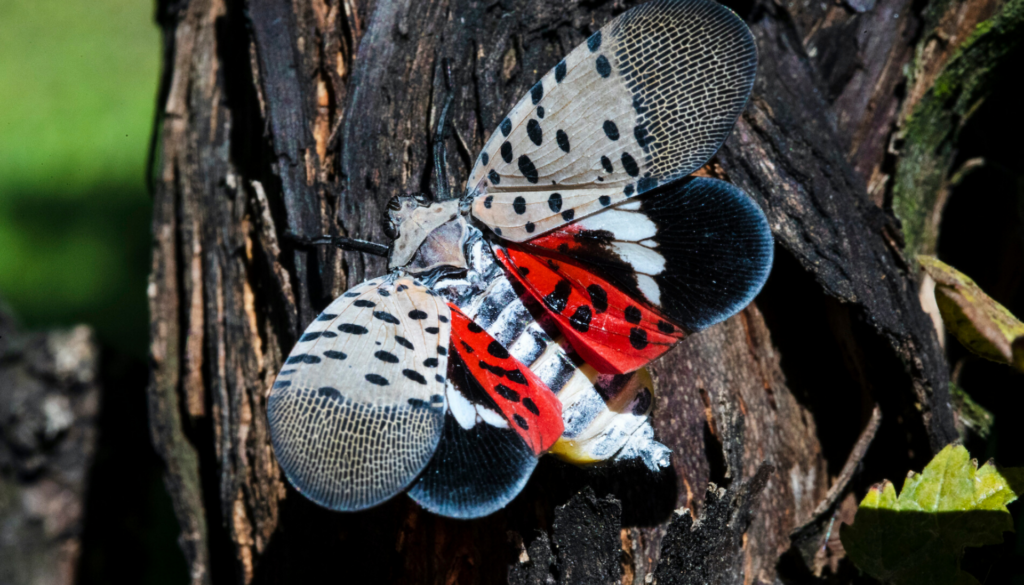
Search and destroy
In March, New Jersey Department of Agriculture Secretary Douglas Fisher, implored property owners to “look for and destroy” any egg masses they encounter. And in the recently passed state budget, over $500,000 was allocated to the department for the management of the invasion.
In 2018 and 2019, the department tested “many synthetic insecticides” on lanternfly egg masses and found that the most effective products were “paraffinic and/or mineral oils such as JMS Stylet oil, Damoil and Lesco Horticultural oil,” which are commonly used by fruit growers and usually available at garden centers.
“The use of oils provides not only a safe, environmentally friendly option but also provides control to some egg masses that are not accessible for physical removal or smashing,” the department says. “However, for egg masses that are within a reachable area, smashing or scraping the egg masses will provide greater efficacy than the ovicides currently available.”
Nielson, of the Rutgers entomology program, recommends homeowners use a combination of traps, which are best for when the lanternfly is in its nymph stage, and soapy-water-solution, neem oil, or insecticides on trees with high numbers — over 100 — of adults. However, she says insecticides should be used with caution and according to the manufacturer’s directions.
Korman also pointed out that natural predators have been identified. People have taken pictures of birds eating the lanternflies, she said, “and we know that praying mantis and spiders will eat them, as well as an insect called the wheel bug, which is a type of an assassin bug.”
For now, restricting the lanternfly’s movement and keeping a close eye on your trees and shrubs remain the most important preventive techniques as it arrives at peak season.
“We’re still learning more about the biology of this creature; it seems to throw us for a loop every year,” Korman said. “But I think, eventually, we will figure out how to crack the nut on how to manage it.”
In the meantime, Nielson added, “they’re not going away anytime soon.”
WHYY is your source for fact-based, in-depth journalism and information. As a nonprofit organization, we rely on financial support from readers like you. Please give today.



